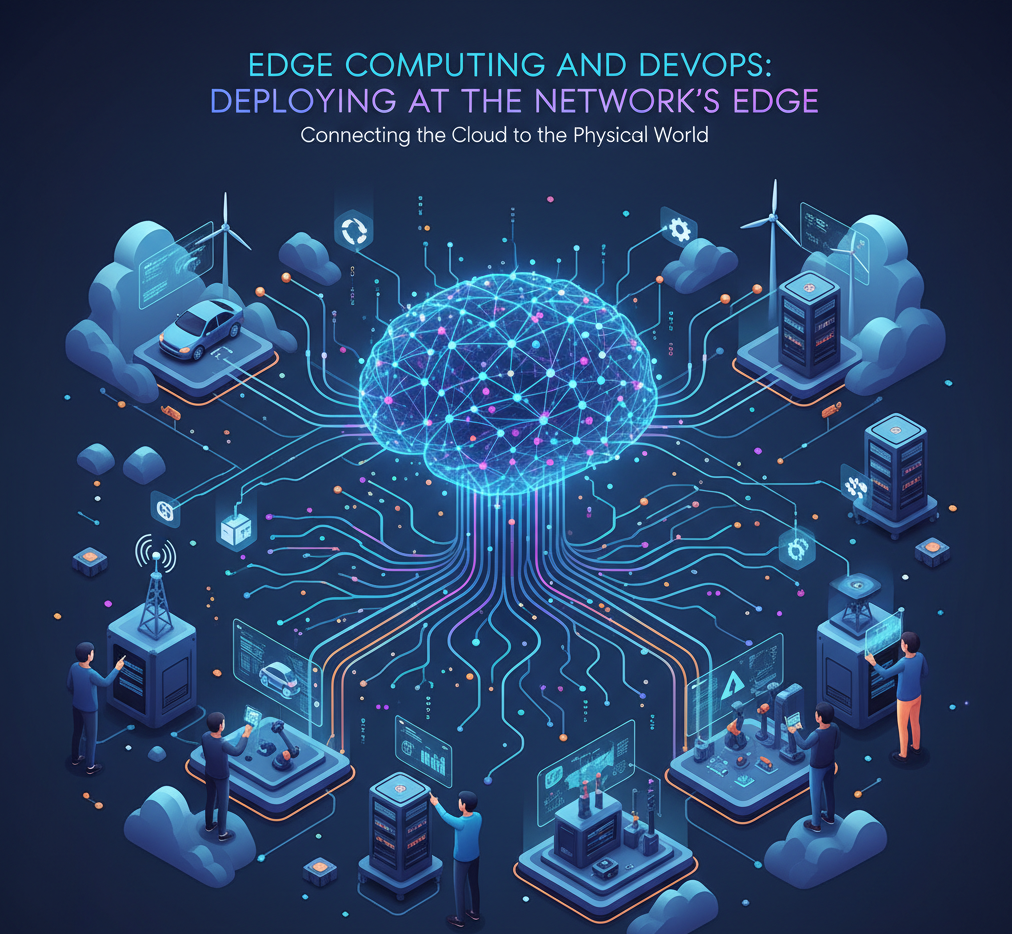Edge Computing and DevOps: Deploying at the Network’s Edge

Introduction
As applications demand lower latency, real-time processing, and high availability, organizations are shifting workloads from centralized data centers to edge locations — closer to users, sensors, and devices.
While edge computing unlocks performance gains, it also introduces new challenges: managing distributed nodes, ensuring consistent deployments, handling limited resources, and maintaining security across hundreds or thousands of edge devices.
This is where DevOps for the edge becomes essential. Deploying at the network’s edge requires automation, resilience, and observability designed for highly distributed environments.
What is Edge Computing?
Edge computing refers to processing data near the source of generation instead of sending everything to a central cloud. This reduces latency, bandwidth usage, and dependency on remote servers.
Common use cases include:
- Autonomous vehicles
- IoT sensor networks
- Retail point-of-sale systems
- Smart factories and robotics
- 5G networks and telecom
Each of these environments needs fast, reliable updates — often to thousands of devices at once — making DevOps mandatory.
Why DevOps at the Edge is Different
1. Highly Distributed Deployment Targets
Instead of a few cloud clusters, edge environments may include hundreds of nodes spread globally.
Challenges: version drift, configuration drift, and unreliable connectivity.
2. Limited Resources
Edge devices often have constrained CPU, memory, and storage.
This requires lightweight containers, optimized pipelines, and minimal footprints.
3. Intermittent Connectivity
Deployments must tolerate failures, auto-retry, or sync when the device reconnects.
4. Strict Security Requirements
Edge nodes exist in physically accessible environments, making them vulnerable.
Updates must be signed, verified, and delivered securely.
DevOps Practices Optimized for the Edge
1. GitOps for Edge Deployments
GitOps—using Git as the single source of truth—helps achieve consistency across distributed nodes. Tools like:
- ArgoCD
- FluxCD
- K3s/K3OS
keep edge devices in sync automatically.
2. Lightweight Kubernetes Distributions
Edge-friendly orchestrators simplify scaling and maintenance:
- K3s for remote/low-power environments
- MicroK8s for edge clusters
- OpenShift for Edge in enterprise settings
These provide consistent APIs across cloud + edge.
3. Immutable Infrastructure
Golden images and immutable updates ensure predictable deployments and eliminate manual drift.
4. Zero-Touch Provisioning (ZTP)
New edge devices auto-configure and join the system without human involvement — critical when managing thousands of nodes.
5. Observability for Distributed Systems
Centralized dashboards help monitor:
- Apps
- Devices
- Connectivity
- Performance
Tools like Prometheus, Grafana, and Loki remain popular, often paired with edge-specific agents.
Benefits of DevOps at the Edge
- Ultra-Low Latency — Faster experiences for end users
- Improved Reliability — Local processing avoids cloud downtime
- Reduced Costs — Less bandwidth, fewer cloud resources
- Rapid Iteration — Automated deployments to distributed nodes
- Consistent Environments — GitOps + orchestration prevents drift
- Better Security — Signed updates and centralized policy enforcement
Example: Edge Deployment in Action
A retail chain with 2,000 stores deploys POS and inventory apps to each location. Instead of manual updates:
- Lightweight Kubernetes runs on each store’s edge node
- GitOps ensures all app versions remain consistent
- Offline stores receive updates once reconnected
- Central teams monitor everything from a single dashboard
Result: faster updates, fewer outages, and reduced operational load.
Edge DevOps Strategy: Step-by-Step
- Identify Your Edge Nodes — IoT devices? Mini clusters? Remote servers?
- Standardize the Runtime — Use k3s or MicroK8s for uniform environments.
- Adopt GitOps — Manage edge configurations via version control.
- Automate Provisioning — ZTP lets new nodes self-configure.
- Secure from the Start — Implement image signing and secret management.
- Measure, Optimize, Scale — Start small, analyze performance, then expand.
Security & Governance at the Edge
Security becomes non-negotiable in edge deployments.
Key practices include:
- Encrypted communication
- Signed container images
- Zero-trust authentication
- Centralized policy enforcement
- Remote patching and rotation of secrets
By simplifying and automating governance, teams reduce risk across thousands of nodes.
The Future: Cloud + Edge + DevOps
The future isn't cloud or edge — it’s a unified model combining both.
With DevOps, teams gain:
- Faster delivery
- Autonomous updates
- Resilient architectures
- Self-healing distributed systems
Edge computing is expanding quickly, and DevOps is the key to making it manageable at scale.
Final Thoughts
Deploying at the network’s edge isn’t just a technical shift — it’s a strategic shift.
Organizations that embrace edge-optimized DevOps unlock:
- Better performance
- Lower latency
- Greater reliability
- Faster innovation
As the number of edge devices grows, DevOps practices must evolve to keep deployments consistent, automated, and secure. In the world of distributed computing, the edge is where DevOps becomes truly essential.